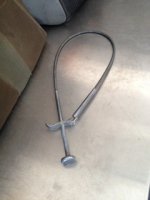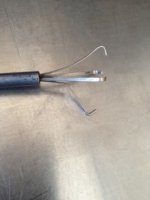JeepFan
Hooked
Spark Plugs and Wire Set Replacement 2007-2011 Jeep Wrangler JK 3.8L
What You Will Need:
3/8” Drive Ratchet
3/8” Torque Wrench
18” Ratchet Extension
3/8” Swivel Socket
3/8” Drive, 5/8” Spark Plug Socket
Mechanical Fingers Tool
Spark Plug Gapper (w/ .050 feeler gauge)
What you will need to get for this job:
(6) Champion Spark Plugs 7440 RE14PLP5 $3.99 each at most auto parts stores.
(1) Wire Set (Part#68017712AC) $60.00 dealer price.
(1) Packet of Dielectric Connector Grease. $1.29 at most auto parts stores.
(1) Wire Tray (Part#5149053AB) Optional. $5.00 dealer price. Special order!
Tech guidelines and notes:
Spark plug gap: (.050) Fifty thousandths of an inch.
Spark plug thread torque: 12 FOOT LBS
Champion does not recommend the use of Anti-Seize on the spark plug threads. Champion plugs have a special coating on the thread body that prevents thread seizure in aluminum heads. The use of Anti-Seize will cause the installer to over torque the spark plug in the cylinder head which could damage the threads in the cylinder head itself.
Changing the spark plugs and wires in your Jeep Wrangler’s engine may be necessary if you notice intermittent miss fires at idle when the engine is in gear and stopped. Chrysler recommends replacing the spark plugs and ignition wires at 102,000 miles but, your mileage may vary depending on the level of modifications you’ve performed on your Jeep, climate, and severe driving conditions.
While changing the spark plugs and wires is a relatively easy task, the passenger side wires and plugs can prove to be a challenge. If you have removed the passenger side fender liner, the job will be much easier. Optionally, you might want to have a new wire tray on hand for the passenger side wire assembly as it might break during removal.
- For safety purposes, disconnect the negative battery cable.
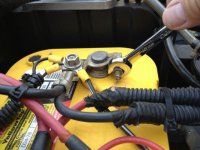
- Remove cylinder #2 (drivers side front) spark plug wire. (You may need to twist the boot left and right to break it loose from the coil and spark plug)
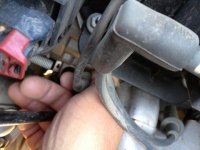
- Using the 3/8” ratchet, extension, swivel and 5/8” spark plug socket, carefully remove the driver side front spark plug. (Note: Before removing the spark plug, take care to remove any debris that may have collected from around the base of the spark plug to prevent foreign objects from falling into the cylinder.
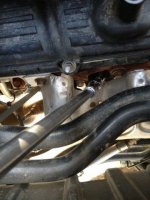
Here’s an old vs. new comparison of the spark plug. Due to wear and tear, you will notice the gap of the old plug has widened quite a bit compared to the new.
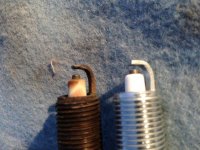
- Using the spark plug gapper, find the .050 gauge feeler and carefully place it between the grounding electrode and center electrode. You should feel a slight drag as you slide the feeler between the gap. If adjustment is needed, use the adjustment slot on the gapper to bend the grounding electrode in or out. Use small movements and recheck the gap frequently. (Important: never pry against or bend the center electrode or damage to the spark plug will occur.)
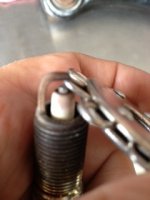
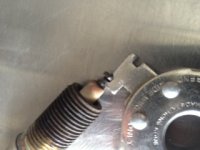
- Insert the spark plug into the 5/8” spark plug socket and carefully lower the spark plug into the threaded hole in the cylinder head. By hand, start turning the socket clockwise to thread the plug into the cylinder head. Use extreme caution while starting the threads; the plug should easily thread into the cylinder head. If you feel it bind as you start to rotate the plug, STOP! Remove the plug and start again. After you have threaded the plug all the way into the cylinder head, set your torque wrench to 12FT. LBS and torque the spark plug.
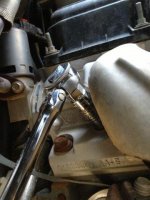
- Add a small amount of Dielectric grease to the coil pack terminal and spark plug terminal and install the wire. You should feel and hear a click as the plug wire terminal seats on the coil pack and spark plug terminals.
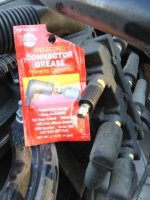
- Repeat the above steps to replace the remaining spark plugs and wires on the driver side.
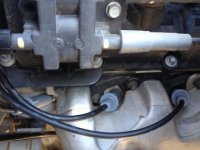
- Disconnect the spark plug wires at the coil using a twisting motion as you pull the plug away from the terminal. Take note of which plug wire connects to the coil pack. You can use a sharpie to write the cylinder number on the plug wire boot. Notice the coil pack has the cylinder number embossed on the case.
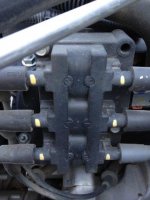
- Disconnect the plug wires from the passenger side spark plugs and carefully lift up on the heater hose retaining bracket to release it from the valve cover stand-off bolt. (This will give you a bit more room to maneuver the wires during installation.) Remove the crankcase vent hose from the valve cover as well.
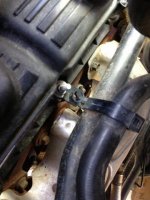
- Carefully lift up on the spark plug wire tray to remove the retainer from the rear valve cover stand-off bolt. Gently pull the wire assembly towards the passenger side and down to work the wires from behind the engine until they are free. Pay attention to the routing of the wires from behind the engine during removal. You may have to push the wires from the driver side a bit to prevent them from hanging up on the engine. (Note: The wire tray is plastic and may break during removal due to being brittle from heat and age. Replacing it at this time might be a good idea.)
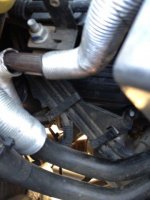
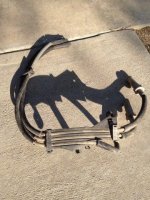
- Remove and replace the passenger side spark plugs.

- Carefully release the clips that hold the spark plug wires to the wire tray. Replace one wire at a time to maintain wire orientation and lengths until you have a complete assembly.
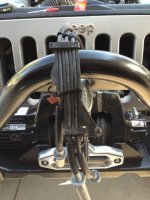
- Using masking tape, wrap the plug wire ends that go to the coil terminals together. (This will help you route the wires behind the engine as an assembly.
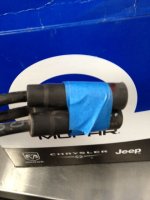
- Route the taped end of the wires behind the rear of the passenger side valve cover from the top of the engine or, from under the wheel well if you removed the fender liner. Push the wires in behind the engine as far as you can until they are almost sticking out on the driver side of the engine. You may have to work the wires a bit to get them in the correct position. Then, using the mechanical fingers tool, grab one of the wire boots and pull it towards the driver side of the engine.
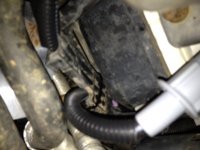
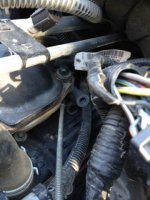
- Reattach the wire tray to the valve cover stand-off bolt and reconnect the spark plug wires to the spark plug terminals. (See right side of picture)

- Reattach the heater hose retainer to the valve cover stand-off bolt and install the crankcase breather hose.

- Connect the spark plug wires to the coil pack terminals in the correct cylinder order after adding a small amount of dielectric grease to the terminals.
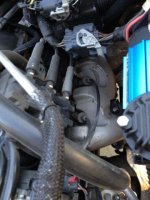
- Check all connections and all work performed. Twice!!
- Make sure you have removed all tools, rags, drop light and fender covers from the engine compartment.
- Re-connect the negative battery cable.
- Make sure your manual transmission is in neutral and apply the brakes before starting the engine; Make sure your automatic transmission is in park and the brake is set before starting the engine.
- After you start the engine you should have a smooth idle.
Done!

